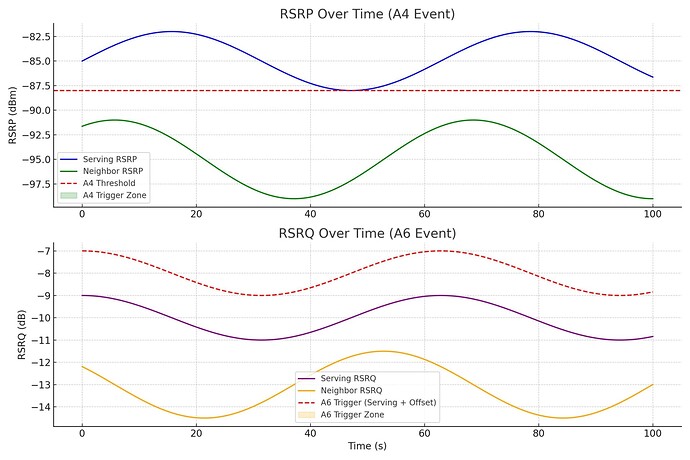As discussed in my previous posts on A1–A2 (serving cell monitoring) and A3–A5 (neighbor cell comparisons), the LTE handover process involves a lot of intelligent decision-making. Let’s now talk about two lesser-known but equally important events: A4 and A6.
![]() A4 Event – Neighbor Cell Above Threshold
A4 Event – Neighbor Cell Above Threshold
Triggered when a neighbor cell’s RSRP or RSRQ exceeds a defined threshold, even if the serving cell is still good.
![]() Use Case: Inter-frequency or inter-RAT measurements.
Use Case: Inter-frequency or inter-RAT measurements.
![]() Common in scenarios with Carrier Aggregation or offloading between layers (e.g., macro to small cell).
Common in scenarios with Carrier Aggregation or offloading between layers (e.g., macro to small cell).
![]() A6 Event – Neighbor Better Than Serving (RSRQ-Based)
A6 Event – Neighbor Better Than Serving (RSRQ-Based)
Triggered when a neighbor cell’s RSRQ becomes better than the serving cell’s RSRQ by a set offset.
![]() Especially useful in congested networks where signal quality, not strength, matters more.
Especially useful in congested networks where signal quality, not strength, matters more.
Often used for VoLTE or capacity-driven handovers.
![]() Telecom Meets Real Life: A Visual Analogy
Telecom Meets Real Life: A Visual Analogy
Imagine you’re driving through a busy city using Google Maps. At first, your current route (Route A – Serving Cell) is smooth and fast. But as you move forward, traffic builds up, and the road slows down (signal quality starts degrading – ![]() RSRP/RSRQ drops).
RSRP/RSRQ drops).
Meanwhile, Google Maps shows another route (Route B – Neighbor Cell) that was average before but is now flowing better (![]() improved signal quality).
improved signal quality).
That’s when the system kicks in:
![]() A4 Event Triggered: “A nearby road is now better – evaluating.”
A4 Event Triggered: “A nearby road is now better – evaluating.”
![]() A6 Event Triggered: “Switching to smoother route.”
A6 Event Triggered: “Switching to smoother route.”
![]() Telecom Analogy:
Telecom Analogy:
Just like your map app helps you switch to the best route, LTE/5G networks use A4 and A6 events to evaluate neighboring cells and hand over your connection for the best quality.
![]() See the image for a clearer picture of how it works!
See the image for a clearer picture of how it works!
![]() Graph Idea:
Graph Idea:
Here’s the graph showing A4 and A6 event scenarios:
Top Graph (RSRP): Demonstrates how the neighbor cell’s RSRP crosses the A4 threshold, triggering measurements.
Bottom Graph (RSRQ): Shows the neighbor RSRQ surpassing the serving RSRQ plus offset, triggering A6.
![]() Optimization Tip:
Optimization Tip:
A4 is crucial in multi-layer LTE deployments to ensure smooth transitions between layers or frequencies.
A6 helps in maintaining call quality, especially for VoLTE users or in load-balanced networks.
LinkedIn: ![]()

